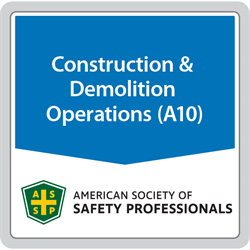Posted by Johann Nacario — April 3, 2024 — The American Society of Safety Professionals (ASSP) has published the first national voluntary consensus standard addressing heat stress for workers in construction and demolition operations. Hundreds of thousands of workers frequently face outdoor hazards such as high heat and humidity.
ASSP President Jim Thornton, CSP, CIH, FASSP, FAIHA, stated:
This new industry consensus standard is an important development because there is no federal regulation focused on heat stress. Employers need expert guidance on how to manage heat-related risks. They must have the tools and resources to identify and help prevent work hazards before an incident occurs.
ANSI/ASSP A10.50-2024, Heat Stress Management in Construction and Demolition Operations, offers guidance on protecting workers; explains how to acclimate workers to high heat conditions; and provides requirements for training employees and supervisors. The standard contains checklists and flowcharts designed to help companies develop clear and effective heat stress management programs that bridge the regulatory gap.
John Johnson, CSP, chair of the ANSI/ASSP A10 standards committee, pointed out:
There are tens of thousands of heat-related illnesses each year linked to construction and demolition sites, and workers have died from exposures to excessive heat. This new standard outlines industry best practices and proven solutions to protect workers who commonly do strenuous jobs in challenging conditions.
 The A10.50 standard identifies engineering and administrative controls a company can implement to ensure that workers get proper rest, water breaks and shade while still meeting business needs. Recommendations such as medical monitoring and using a buddy system can reduce risks and help prevent heat-related illnesses in many work environments.
The A10.50 standard identifies engineering and administrative controls a company can implement to ensure that workers get proper rest, water breaks and shade while still meeting business needs. Recommendations such as medical monitoring and using a buddy system can reduce risks and help prevent heat-related illnesses in many work environments.
While the scope of the standard focuses on construction and demolitions, the guidance can be adapted to protect workers performing other outdoor jobs such as tree trimming, farming, road maintenance and pipeline painting.
The impacts of heat stress can range from mild symptoms such as heat rash and heat cramps to severe conditions including heat exhaustion and heat stroke, which can be fatal. According to the U.S. Bureau of Labor Statistics, more than 400 work-related deaths have been caused by environmental heat exposure since 2011. The standard includes a detailed emergency response plan if a worker has a severe reaction to excessive heat.
The A10.50 subcommittee that wrote the standard consisted of 30 safety and health experts from businesses, trade unions, consulting firms, universities and government agencies. The inclusive process took three years.
Voluntary consensus standards provide the latest expert guidance and fill gaps where federal standards don’t exist. Companies rely on them to drive improvement, injury prevention and sustainability. With government regulations being slow to change and often out of date, federal compliance is not sufficient to protect workers, says ASSP, which leads the development of voluntary consensus standards for the workplace.
ANSI/ASSP A10.50-2024, Heat Stress Management in Construction and Demolition Operations, is available from the ASSP Store.
Companies are encouraged to join ASSP in spreading awareness of heat-related hazards on National Heat Awareness Day on May 31 and during Extreme Heat Awareness Month in July.
See also on FMLink:
- OSHA launches first-ever national program to protect workers from indoor and outdoor heat hazards
- OSHA offers compliance assistance tools to help you identify workplace hazards before they cause injury, and guidance on keeping workers safe in summer heat
- CDC/OSHA report reveals need for heat acclimatization to prevent worker deaths
And these resources from OSHA:





